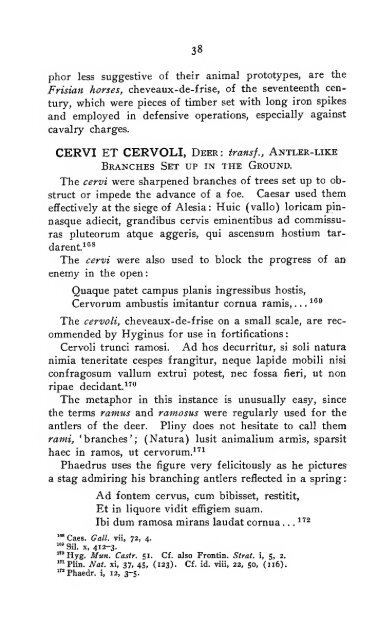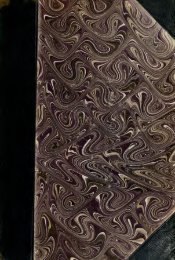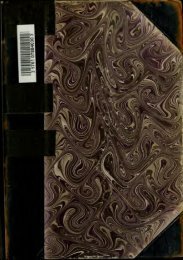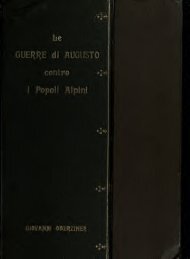Figurative uses of animal names in Latin and their ... - mura di tutti
Figurative uses of animal names in Latin and their ... - mura di tutti
Figurative uses of animal names in Latin and their ... - mura di tutti
You also want an ePaper? Increase the reach of your titles
YUMPU automatically turns print PDFs into web optimized ePapers that Google loves.
38<br />
phor less suggestive <strong>of</strong> <strong>their</strong> <strong>animal</strong> prototypes, are the<br />
Frisian horses, cheveaux-de-frise, <strong>of</strong> the seventeenth cen-<br />
tury, which were pieces <strong>of</strong> timber set with long iron spikes<br />
<strong>and</strong> employed <strong>in</strong> defensive operations, especially aga<strong>in</strong>st<br />
cavalry charges.<br />
:<br />
CERVI ET CERVOLI, Deer: transf., Antler-like<br />
Branches Set up <strong>in</strong> the Ground.<br />
The cervi were sharpened branches <strong>of</strong> trees set up to obstruct<br />
or impede the advance <strong>of</strong> a foe. Caesar used them<br />
effectively at the siege <strong>of</strong> Alesia: Huic (vallo) loricam p<strong>in</strong>nasque<br />
a<strong>di</strong>ecit, gr<strong>and</strong>ibus cervis em<strong>in</strong>entibus ad commissu-<br />
ras pluteorum atque aggeris, qui ascensum hostium tar-<br />
darent."*<br />
The cervi were also used to block the progress <strong>of</strong> an<br />
enemy <strong>in</strong> the open<br />
Quaque patet campus planis <strong>in</strong>gressibus hostis,<br />
^®®<br />
Cervorum ambustis imitantur cornua ramis, . . .<br />
The cervoli, cheveaux-de-frise on a small scale, are recommended<br />
by Hyg<strong>in</strong>us for use <strong>in</strong> fortifications<br />
Cervoli trunci ramosi. Ad hos decurritur, si soli natura<br />
nimia teneritate cespes frangitur, neque lapide mobili nisi<br />
confragosum vallum extrui potest, nee fossa fieri, ut non<br />
ripae decidant. '''*'<br />
The metaphor <strong>in</strong> this <strong>in</strong>stance is unusually easy, s<strong>in</strong>ce<br />
the terms ramus <strong>and</strong> ramosus were regularly used for the<br />
antlers <strong>of</strong> the deer. Pl<strong>in</strong>y does not hesitate to call them<br />
rami, 'branches'; (Natura) lusit <strong>animal</strong>ium armis, sparsit<br />
haec <strong>in</strong> ramos, ut cervorum.'^'^^<br />
Phaedrus <strong>uses</strong> the figure very felicitously as he pictures<br />
a stag admir<strong>in</strong>g his branch<strong>in</strong>g antlers reflected <strong>in</strong> a spr<strong>in</strong>g<br />
Ad fontem cervus, cum bibisset, restitit,<br />
Et <strong>in</strong> liquore vi<strong>di</strong>t effigiem suam.<br />
Ibi dum ramosa mirans laudat cornua . .<br />
Caes. Gall, vii, 72, 4.<br />
"» Sil. X, 412-3-<br />
"°Hyg. Mun. Castr. 51. Cf. also Front<strong>in</strong>. Strat. i, 5, 2.<br />
'"Pl<strong>in</strong>. Nat. xi, 37, 45, (123). Cf. id. viii, 22, 50, (116).<br />
'"Phaedr. i, 12, 3-5.<br />
:<br />
.^''^<br />
:



![Das Kriegswesen der Alten [microform] - mura di tutti](https://img.yumpu.com/21606999/1/167x260/das-kriegswesen-der-alten-microform-mura-di-tutti.jpg?quality=85)








